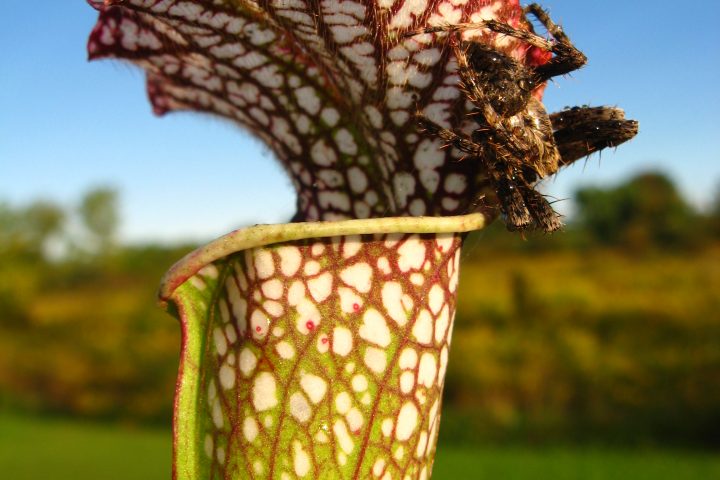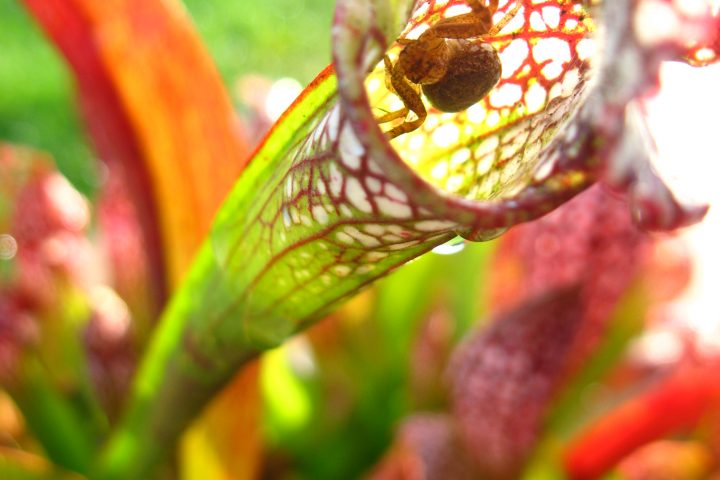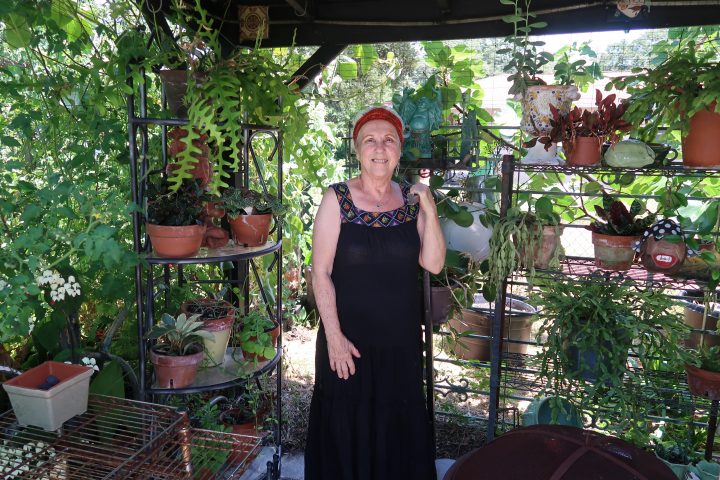As a transplant from the North, I find the line between indoor and outdoor plants a blur. Scheffleras, palms and bromeliads flourish in the Florida landscape, while in New York they were only thought of as house plants. Below is a guide to keeping plants indoors, whether it be for overwintering or year-round enjoyment.
It would be hard to imagine a house in the 1970’s without macramé and hanging plants in the family room. But people have been keeping houseplants, long before then. With the invention and perfection of glass windows, people started to bring the outdoors in. During the Victoria era (1837 to the early 1900’s) indoor plants were considered a symbol of respectability. Today people care for houseplants for cleaner air, companionship and to nurture one’s soul.
Aloe Aloe vera
Display Tips By growing aloe near your kitchen the more efficiently you will be able to treat a burn. Pretty plump elongated leaves fan out from a central base, whose pups can be cut off in spring or summer to propagate even more medicinal goodness.
Fertilizer From spring to fall feed monthly. In winter, do not feed.
Indoor Temperature 65-75°F
Light Bright.
Water Keep slightly moist, in winter water less.
Zone 9-11
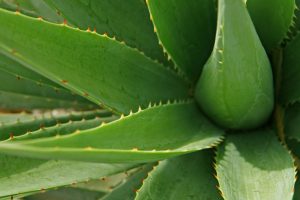
Bamboo Palm Chamaedorea seifrizii
Display Tips This slow growing palm has tropical bamboo like leaves. It is known to filter out both benzene and trichloroethylene. With compact foliage, it grows to about 7 feet tall in the house.
Fertilizer Monthly.
Indoor Temperature 65-80°F
Light Low to Moderate.
Water Keep slightly moist.
Zone 10-11
Chinese Evergreen Aglaonema commutatum
Display Tips Pothos, ZZ plants and Sansevieria’s complement Chinese Evergreens very well due to their complementary hues and textures. Chinese Evergreens tolerate low light situations better than most houseplants. This plant has a lot of varieties to choose from. Developed by the University of Florida, ‘Golden Bay’, shows off gray-green leaves with a creamy-white center and silvery variegation. While ‘Silver Bay’ has silvery leaves outlined in rich, deep green. ‘Red Gold’ offers bright colors such as red, gold, green and cream on one plant. ‘Romeo’ has long, slim silver leaves marked with dark green.
Fertilizer From spring to fall feed monthly. In winter, every 6 weeks.
Indoor Temperature 65-75°F
Light Low indoor light, near a North or East window.
Water Keep slightly moist.
Zone 10-11
Croton Codiaeum variegatum var.
Display Tips Easily seen in the landscapes of Florida, technicolor crotons offer a homeowner a wide range of options to choose from when interior designing. Also known as Joseph’s coat, this plant is one of the most widely sold foliage plants. They are easy to propagate and come in bold leaf colors such as red, yellow, orange, and yellow-and-green combinations. Some of my favorite varieties include, ‘Bush on Fire,’ ‘Gold Dust,’ ‘Lauren’s Rainbow,’ ‘Mammy,’ and ‘Zanzibar’.
Fertilizer Every 2 weeks in spring and summer. Monthly, the rest of the year.
Indoor Temperature 60-85°F
Light Bright light is preferred. Will benefit from spending summer outdoors, if acclimated to the sun first.
Water Keep slightly moist.
Zone 9-15
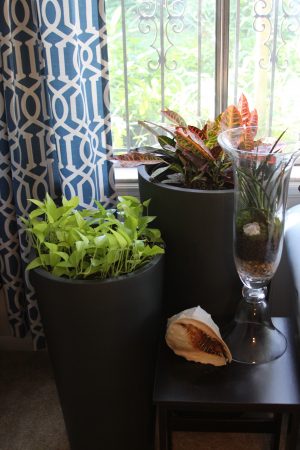
Crown of Thorns Euphorbia milii hybrids
Display Tips In Thailand this plant is known to bring the caregiver luck in life, based on the number of flowers the plant produces. A local Thai temple has a plethora of these beautiful blooming bracts flanking their walkways. Solid and variegated varieties are available. ‘Jingle Bells’ has soft pink bracts touched with red and green; ‘New Year’ has buttery yellow bracts that change to cherry red as they age; ‘Pink Christmas’ has cream bracts that develop pale pink and reddish streaks; and ‘Spring Song’ grows creamy yellow bracts.
Fertilizer Every 2 weeks in spring and summer. Monthly, the rest of the year.
Indoor Temperature 50-90°F
Light Bright
Water Allow soil to dry between watering.
Zone 10-11
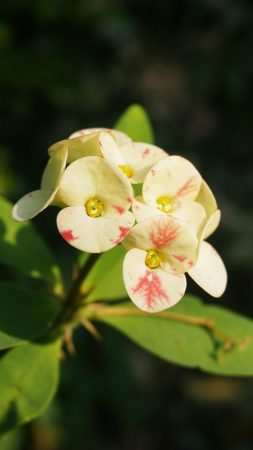
Dracaena Dracaena sp.
Display Tips With around 40 varieties to choose from, Dracaena’s bold splash of color and texture will surely fit any indoor aesthetic. D qifferent than the other varieties, ‘Florida Beauty’ has rounded leaves generously dabbled in golden-yellow marks. ‘Limelight’ featured in an earlier issue of FG, is a fantastic variety for brightening your home with chartreuse leaves. ‘Janet Craig’, one of the most common houseplants of all time, features dark green, shiny leaves and is easy to grow. When mature, Dracaena’s stems resemble woody trees with many reaching 5 to 6 feet.
Fertilizer Every 2 weeks in spring and summer. Monthly, the rest of the year.
Indoor Temperature 65-75°F
Light Moderate to Bright.
Water Keep slightly moist.
Zone 9-11
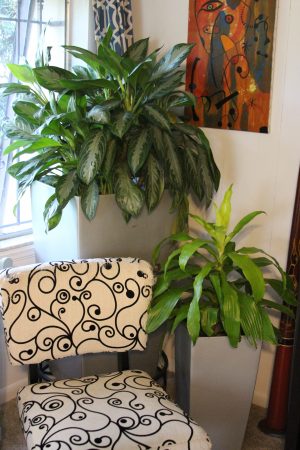
Earth Star Crypanthus sp.
Display Tips Young plants look great in terrariums, while older plants are ideal for humid rooms where space is limited. Great addition for low windowsills, where they can be enjoyed from above. A small bromeliad, their flowers are small and hidden, making their starry, wavy, sharp-tipped leaves the primary reason to grow them. Strong light strengthens the pink leaf colors.
Fertilizer Apply half strength fertilizer every two months.
Indoor Temperature 60-80°F
Light Bright
Water In spring and summer, keep roots slightly moist. In fall and winter, can be kept dryer but do not let roots dry out completely.
Zone 10-11
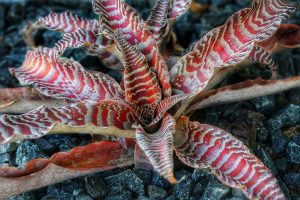
Elkhorn Fern Polypodium grandiceps
Display Tips A gnarly version of a bird’s nest fern, this plant can tolerate more light then other ferns. Also called Climbing Bird’s Nest Fern, Dwarf Elkhorn Fern and Fishtail Strap Fern. Grows to 18” high and 18” wide.
Fertilizer Not a heavy feeder, but will benefit from a little plant food during new growth.
Indoor Temperature 60-75°F
Light Low.
Water Moist soil.
Zone 10b-11
Fiddle Leaf Fig Ficus lyrata
Display Tips A tough plant that easily adapts to various conditions, this musical fig is a huge specimen plant with slightly wavy, green leaves. When outside they can reach a towering 40 feet tall and produce edible fruits. Each leaf can grow more than 12 inches wide. Can be trained into various shapes. Plants convey elegance and look great as single specimens or when their trunks are braided.
Fertilizer Feed three times a year a high-nitrogen plant food.
Indoor Temperature 60-85°F
Light Bright to moderate.
Water Avoid overwatering, although requires more water than other ficus species.
Zone 10-12
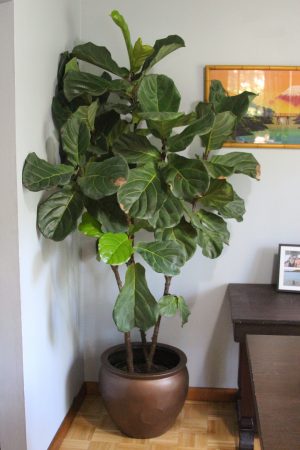
Flowering Maple Abutilon hybridum
Display Tips Related to hollyhocks, this plant produces delicate papery blossoms year-round, when given good light. In addition to pots or hanging baskets, abutilon can be trained to look like a tree. Abutilon has been hybridized to dozens of named cultivars. Variegated cultivars tend to have weaker blooms. Once the plant is 3 to 3 years old, take 4-inch stem cuttings as an insurance policy.
Fertilizer Every 2 weeks in spring and summer. Monthly, the rest of the year.
Indoor Temperature 65-75°F
Light Bright.
Water Water thoroughly and then let dry before watering again.
Zone 9-11
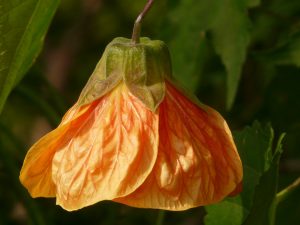
Gardenia Gardenia jasminoides
Display Tips Yes, this fragrant plant can be kept indoors, especially if the right cultivar is selected. ‘White Gem’ is the most popular container gardenia whose upright growing habit reaches 24 inches tall. ‘Radicans’ is another dwarf variety that is good to train as bonsai. ‘Veitchii’ is sometimes called everblooming gardenia, is a taller variety and is a good choice for large sunrooms.
Fertilizer Feed every two weeks with a formula that contains micronutrients, especially iron.
Indoor Temperature 60-75°F
Light Bright.
Water Slightly moist, avoid overwatering.
Zone 8-11
Haworthia Haworthia sp. snd hybrids
Display Tips Due to their petite size, Haworthias can be grow in novel containers like decorative tins, mugs or teacups. They make great accent plants for dish gardens.
Fertilizer From spring to fall feed monthly. In winter, do not feed.
Indoor Temperature 70-80°F
Light Bright, indirect light.
Water Allow soil to dry between watering.
Zone 9-11
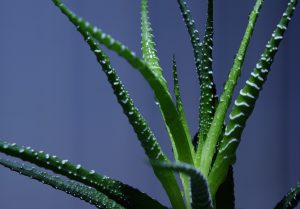
Hibiscus Hibiscus rosa-sinensis hybrids
Display Tips Hibiscus grows the largest blossoms of indoor plants. To control the size lightly prune in early summer and more aggressively in the fall. ‘Dragon Breath’ features bold red flowers with white swirls in the center. The flowers can reach 8 inches. ‘The Path’ is bright yellow with magenta centers.
Fertilizer Every 2 weeks in spring and summer. Monthly, the rest of the year.
Indoor Temperature 65-85°F
Light Bright, including direct sun.
Water Moist in summer, allow to dry between watering in winter.
Zone 9-11
Moth Orchid Phalaenopsis sp. snd hybrids
Display Tips Flowers last 6 weeks or longer. Grow alongside or in foliage plants to showcase their bright flowers.
Fertilizer Half strength fertilizer weekly during spring and summer.
Indoor Temperature 65-80°F
Light Moderate to Bright.
Water Allow soil to dry between watering.
Zone 10-12
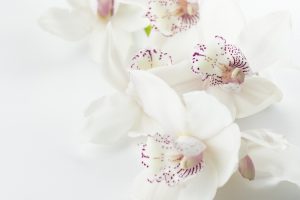
Mother-In-Law-Tongue, Snake Plant Sansevieria sp.
Display Tips This plant is a staple in landscaping around my neighborhood. Up North it was a household mainstay. Sansevieria can live 20 years or more, out lasting many mother-in-laws. Although this plant tolerates neglect it responds to good care, again like mother-in-laws. ‘Cylindrica’ is an interesting variety with round stems that grow up out of the pot like pencils. These stems can also be braided together. ‘Futura Robusta’ is a compact variety that has silvery-green leaves mottled with dark green. ‘Moonshine’ is one of the most beautiful varieties, with silvery green leaves. It’s especially spectacular mixed with dark-leaf varieties.
Fertilizer From spring to fall feed monthly. In winter, do not feed.
Indoor Temperature 65-75°F
Light Bright to moderate.
Water Slight moist, in winter water less.
Zone 9b-11
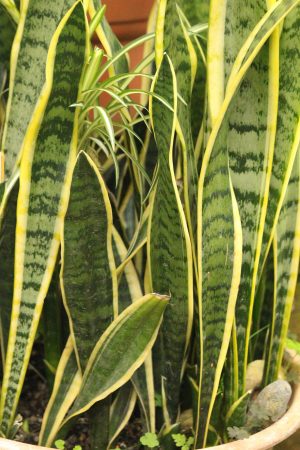
Oxalis Oxalis sp.
Display Tips This plant is sometimes considered a weed in Florida, yet sold and displayed as a houseplant up North. Some people say weed, some say houseplant and I say: it’s edible! Also known as a shamrock plant, triangular clove-like leaves support the delicate flowers.
Fertilizer Every two weeks.
Indoor Temperature 60-75°F
Light Bright to Moderate.
Water Light.
Zone 8-11
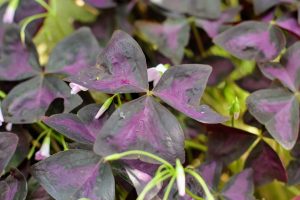
Peace Lily Spathiphyllum wallisii
Display Tips The ubiquitous house plant, peace lilies are good to have around. In NASA studies, they were shown to remove formaldehyde, benzene, and carbon monoxide from the air. Small varieties grow to about 16 in tall, while larger ones can reach 6 ft. Cut flowering stems when the blossoms turn green. Once settled they will flower in early summer, while some cultivars have been bred to bloom intermittently.
Fertilizer From spring to fall feed a diluted solution at half strength, monthly. In winter, every 6 weeks.
Indoor Temperature 65-75°F
Light Low to Moderate.
Water Keep slightly moist.
Zone 10
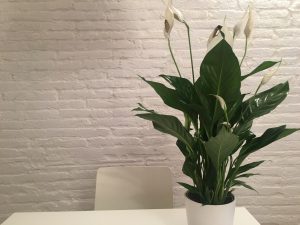
Pothos Epipremnum aureum
Display Tips Place on top a tall piece of furniture or filing cabinet to make most of its draping downward characteristic. I recently saw a restaurant display a 20-foot-long pothos sprawl across the ceiling that looked very impressive. ‘Golden’ has average green, heart-shaped leaves streaked with golden-yellow variegation and is quite common. ‘Manjula’ is similar and shows off creamy-white leaves edged and is also variegated in green. ‘Satin’ has dark green heart-shaped leaves adorned with irregular silver spots. It’s excellent in hanging baskets or climbing up a moss or wood totem.
Fertilizer Every 2 weeks in spring and summer. Monthly, the rest of the year.
Indoor Temperature 60-80°F
Light Moderate to Light.
Water Allow soil to dry between watering.
Zone 10-11
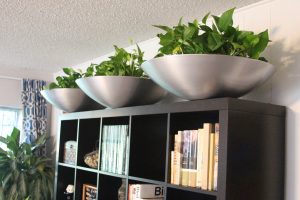
Schefflera Schefflera arboricola
Display Tips While all green varieties grow faster, “Trinette” is the most commonly grown variegated cultivar and looks great as an accent.
Fertilizer Monthly.
Indoor Temperature 65-80°F
Light Bright.
Water Allow soil to dry between watering.
Zone 9b-11
Swedish Ivy Plectranthus australis
Display Tips Great for the workplace or home. This beginner hanging basket plant produces cascading stems with scalloped leaves. If you are limited on space prune back vines in the fall. Stem tip cuttings can be easily taken in the summer, after it has bloomed.
Fertilizer From late spring to late summer, when plant is blooming. If cut back in the fall, no fertilizer is needed.
Indoor Temperature 60-75°F, can tolerate low temperatures of 40°F for short periods of time.
Light Moderate.
Water Moderate.
Zone 9-11
To learn more about homesteading check out my newest book: 99½ Homesteading Poems
 Originally published in Florida Gardening Magazine Winter 2017.
Originally published in Florida Gardening Magazine Winter 2017.

